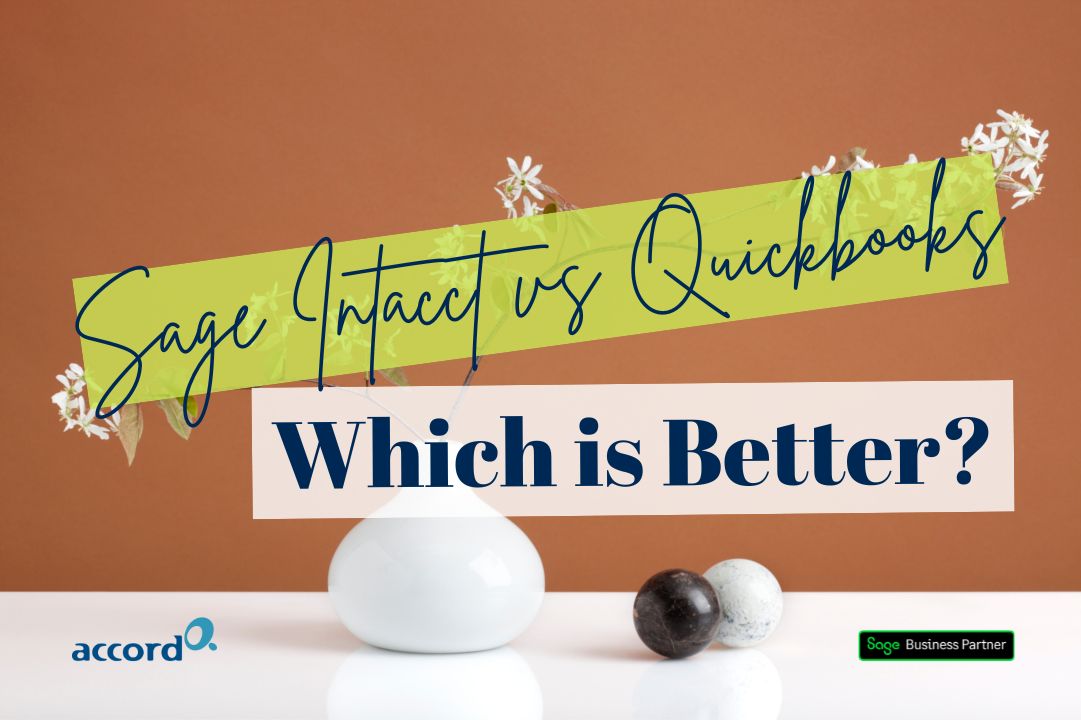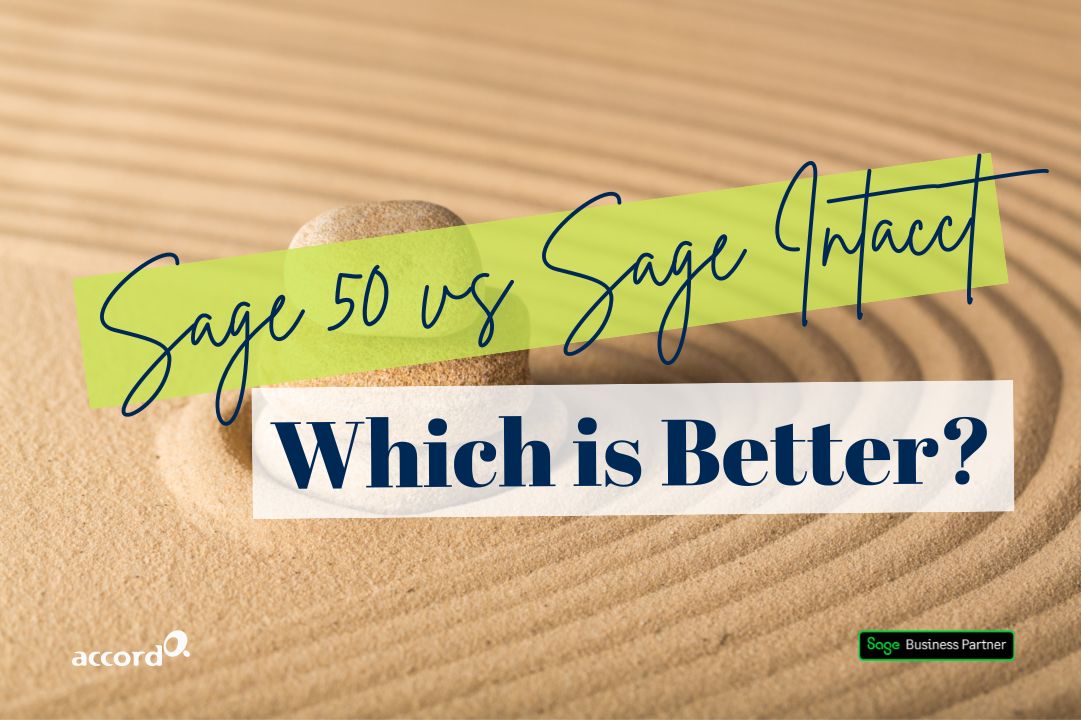Compare Sage Intacct with other accounting solutions to find the best fit for your business. Discover its advanced features, cloud-native design, and why it’s trusted by growing organisations worldwide.
Choosing the right financial management software can be overwhelming, especially with so many options on the market. Businesses need a solution that not only addresses their current challenges but also supports their future growth.
Sage Intacct is a leader in cloud-based financial management, designed to provide organisations with the tools they need to streamline operations, improve decision-making, and scale effectively. But how does it compare to other accounting software?
This guide explores Sage Intacct alongside other popular solutions, helping you understand the differences and why Sage Intacct might be the best fit for your business needs.
Below is a full list of our comparisons; click on the title to jump to that section on the page!
Want to jump straight onto a call with us to see Sage Intacct in action?
Book your free Sage Intacct Discovery Call here
Sage Intacct vs Sage 200

Sage Intacct is a cloud-native financial management solution designed for growing businesses seeking advanced capabilities like real-time reporting, multi-entity consolidation, and seamless scalability.
Sage 200, on the other hand, offers a hybrid approach, combining desktop software with cloud-connected features. While it caters to small-to-medium businesses, its functionality can be limiting as organisations outgrow Sage 200.
Key differences
- Cloud-Native Design: Sage Intacct operates entirely in the cloud, providing accessibility from any device, whereas Sage 200 requires a combination of desktop and cloud environments.
- Real-Time Insights: With Sage Intacct, users can generate detailed, up-to-the-minute reports. Sage 200’s reporting is less dynamic and often requires manual data manipulation.
- Scalability: Sage Intacct is built to grow with your business, offering features like multi-entity management. Sage 200 is better suited for businesses with simpler structures.
- Automation: Sage Intacct includes robust automation tools for accounts payable, accounts receivable, and more, reducing manual workloads. Sage 200 offers some automation but lacks the same depth.
Read our full comparison here
Sage Intacct vs Xero

Sage Intacct is purpose-built for growing businesses that need advanced financial tools, such as automation, multi-entity support, and powerful reporting.
Xero is a popular choice for small businesses and startups, offering basic accounting features and a user-friendly interface. While it’s a popular starting point for smaller businesses, Xero’s functionality can fall short for organisations with more complex financial needs.
Key Differences
- Scalability: Sage Intacct handles multi-entity and global consolidations effortlessly, while Xero is designed for single-entity organisations with simpler structures.
- Reporting: Sage Intacct provides robust, customisable reporting with drill-down capabilities. Xero’s reporting is basic and less flexible for detailed financial insights.
- Automation: Sage Intacct automates key processes like accounts payable and intercompany transactions. Xero offers automation for basic tasks but lacks the depth needed for complex operations.
- User Limitations: Sage Intacct supports unlimited users with role-based permissions, while Xero places restrictions on the number of users per plan.
Read our full comparison here
Sage Intacct vs QuickBooks

Sage Intacct is a sophisticated financial management platform tailored to organisations seeking enhanced control over their finances, advanced automation, and the flexibility to adapt to future growth.
QuickBooks is another widely-used solution for small businesses, offering basic accounting features. However, its capabilities can become restrictive for businesses with more intricate financial structures or expanding operational needs.
Key Differences
- Advanced Financial Management: Sage Intacct excels in handling complex financial workflows, such as multi-entity consolidations and revenue recognition. QuickBooks is better suited for simpler financial setups.
- Customisation and Reporting: With Sage Intacct, users can generate comprehensive, real-time reports tailored to their needs. QuickBooks offers limited customisation and fewer advanced reporting options.
- Scalability: Sage Intacct grows alongside your business, supporting increasing financial complexity. QuickBooks struggles to keep pace with scaling organisations.
- Integration Capabilities: Sage Intacct integrates seamlessly with a wide array of systems, creating a connected financial ecosystem. QuickBooks has more limited integration options, which can hinder efficiency.
Read our full comparison here
Sage Intacct vs Sage 50

Sage Intacct delivers modern financial management capabilities for organisations ready to embrace cloud-based technology and streamline complex processes. With its emphasis on automation, scalability, and real-time insights, it’s designed to meet the demands of growing businesses.
Sage 50, often viewed as an entry-level solution, caters to small businesses needing straightforward accounting tools. While reliable for basic needs, Sage 50 can quickly become a bottleneck for companies looking to scale or modernise.
Key Differences
- Cloud Functionality: Sage Intacct offers a fully cloud-native experience, ensuring real-time access and collaboration. Sage 50 relies on desktop software with limited cloud integrations.
- Multi-Entity Support: Sage Intacct provides seamless multi-entity management, making it ideal for organisations with multiple locations or subsidiaries. Sage 50 lacks this capability.
- Automation and Efficiency: Sage Intacct automates key workflows like accounts payable, intercompany transactions, and revenue recognition, minimising manual intervention. Sage 50’s automation features are basic in comparison.
- Future-Readiness: Sage Intacct supports growing businesses by offering tools to manage increasing complexity. Sage 50 is best suited for organisations with limited operational requirements.
Read our full comparison here
Sage Intacct vs NetSuite

Sage Intacct is a best-in-class financial management solution, purpose-built to empower finance teams with advanced automation, precise insights, and unmatched scalability. Designed specifically for accounting, it excels in streamlining and optimising financial operations.
NetSuite positions itself as a comprehensive ERP platform, offering a broad range of functionalities beyond accounting. While its wide scope may suit organisations seeking an all-in-one solution, this can make it less specialised and more complex for purely financial management needs.
Key Differences
- Specialisation vs Generalisation: Sage Intacct focuses exclusively on accounting and finance, delivering deep functionality in areas like revenue recognition and multi-entity consolidation. NetSuite provides broader ERP tools but lacks the same level of financial specialisation.
- Ease of Use: Sage Intacct’s intuitive design is crafted for finance professionals, ensuring a smoother onboarding experience. NetSuite’s extensive features can result in a steeper learning curve.
- Cost Efficiency: Sage Intacct offers a cost-effective solution for organisations seeking advanced financial capabilities without the overhead of unnecessary ERP features. NetSuite’s expansive functionality often comes with higher (and many hidden) costs.
- Customisation and Reporting: Sage Intacct enables finance teams to create highly tailored, real-time reports, while NetSuite’s reporting tools, though extensive, can be less user-friendly.
Read our full comparison here
Sage Intacct vs Traditional Accounting Software

Sage Intacct offers a forward-thinking approach to financial management, leveraging cloud-native technology to enhance efficiency, visibility, and collaboration. Its modern capabilities equip businesses with the tools they need to thrive in an ever-evolving digital landscape.
Traditional accounting software, often built on older, on-premise frameworks, can still handle basic accounting tasks but lacks the agility and functionality required by growing businesses in today’s fast-paced environment.
Key Differences
- Cloud Accessibility: Sage Intacct enables real-time access to financial data from anywhere, while traditional software requires on-premise infrastructure and is less flexible for remote teams.
- Automation: Sage Intacct streamlines workflows through advanced automation, reducing manual tasks like reconciliations and approvals. Traditional systems often rely heavily on manual processes.
- Real-Time Insights: Sage Intacct delivers dynamic, up-to-the-minute reporting, giving organisations the insights needed for timely decisions. Traditional software typically requires manual report generation, leading to delays.
- Scalability and Integration: Sage Intacct scales seamlessly as businesses grow and integrates with a wide range of systems. Traditional accounting tools often struggle to keep pace with increasing complexity.
Read our full comparison here
Conclusion
The right financial management software doesn’t just improve your team’s processes — it empowers businesses to operate more efficiently, make smarter decisions, and achieve their goals. Sage Intacct offers a proven solution, combining cloud-native capabilities, advanced automation, and deep financial insights to help your organisation thrive.
Accord Consulting is here to make your transition to Sage Intacct as seamless as possible. With our expertise, you’ll gain a system that aligns perfectly with your business needs and the support to get the most from your investment.
Ready to see how Sage Intacct can work for you? Schedule a free 30-minute Discovery Call with one of our experts today by clicking the button below.
Book your free Sage Intacct Discovery Call here